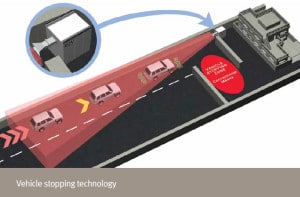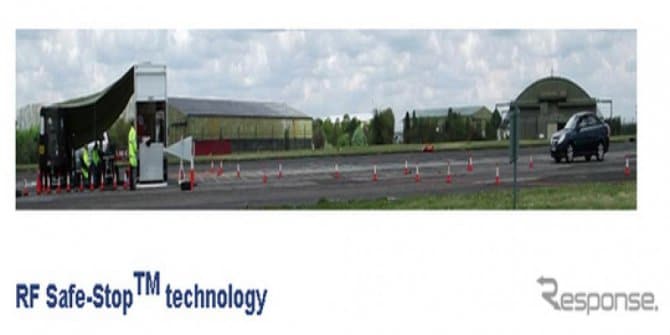You could call it “The Death of the Car Chase.” According to the BBC, a UK company, E2V is demonstrating the RF Safe-Stop, a 350 KG (770 lb) device that can shoot RF (radio frequency) pulses at moving vehicles, “confusing” the vehicle’s electronic systems and causing its engine to shut off, stranding both vehicle and driver.

E2V’s Safe-Stop product is intended for use as a non-lethal weapon for the military and law enforcement and is marketed as a tool for “checkpoint enhancement,” “convoy protection” and “vehicle immobilisation” (sp). According to this BBC report, the device acts like a small radar transmitter, directing a beam of radio pulses (identified elsewhere as L and S-Band RF pulses) that saturate the wiring that connects the vehicles on board systems. Those pulses confuse the engine control unit and cause it to reset, stopping the vehicle. Safe-Stop sends a continuous stream of pulses to keep the ECU confused and prevent the vehicle from restarting.
The idea here isn’t new. At the most recent DEFCON conference, a pair of security researchers showed how late model vehicles, including Toyota’s Prius hybrid, could be hacked by manipulating the input and output of onboard sensors, causing the vehicle to suddenly brake or veer. But the E2V product suggests ways that onboard electronics could also be manipulated to deny individuals’ freedom of movement.
According to the BBC report, when the Safe-Stop is fired something similar occurs with dashboard warning lights and dials behaving erratically and the engine stopping. Onboard digital audio and video recording devices in the vehicle were also affected, the BBC reported.
The device is non-lethal and non-destructive, E2V claims. It also works against a wide range of vehicles including motorcycles and boats (“harbor security” is listed as one of Safe-Stop’s applications). However, older model vehicles that don’t rely extensively on on-board electronics would be immune to Safe-Stop. ”
[For more on security and connected vehicles, check out “Insecure at any speed: are automakers failing the software crash test?“]
Technology is absolutely revolutionizing transportation. As this blog has noted more than once, the proliferation of onboard, wireless sensors has greatly expanded features like anti-collision and driver alerting systems, potentially saving tens of thousands of lives a year.
But all that technology also introduces new problems – many of which aren’t fully appreciated in the initial flush of “gee whiz” excitement that accompanies new features and capabilities. We’ve written, for example, about the liability issues raised by accidents involving autonomous vehicles, and about how sensor and monitoring tools that can help you recover a lost automobile or observe how you drive might also be used to infer (accurately) where you drive.

The ongoing revelations of NSA spying that have followed from the classified leaks tied to Edward Snowden suggest the ways that intelligence agencies and authorities are harvesting “metadata” and other digital artifacts as routine part of intelligence gathering. Safe-Stop raises the prospect that smart devices, including smart cars, may come with serious and hidden costs when it comes to personal liberty and privacy.
The Supreme Court ruled almost two years ago that GPS tracking constitutes a “search” governed by the Fourth Amendment’s protections against search and seizure. But the Electronic Frontier Foundation (EFF) has already warned that many prosecutors haven’t received the memo, and that there is a creeping danger to privacy protections as GPS sensors get cheaper and smaller.
Tools like Safe-Stop raises the prospect that the increasing technologic sophistication of automobiles, while providing safety and comfort advantages to drivers, might also make it easier for authorities to restrict the movement and liberties of the individuals who use the technology.
The solution may be to go ‘back to the future,’ investing in antique vehicles that rely on mechanical and analog systems to operate.
“Certainly if you took a 1960s Land Rover, there’s a good chance you’re not going to stop it,” Andy Wood, an E2V Product Manager told the BBC.


Pingback: Top ten security stories of the week | David Strom's Web Informant